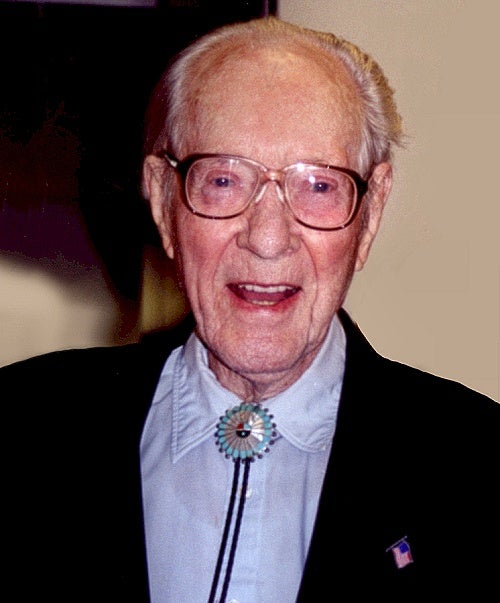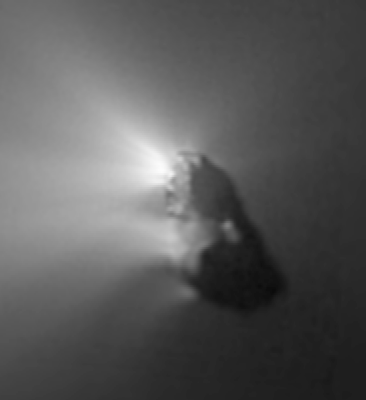
August 31, 2004
If you’ve ever heard a comet described as a “dirty snowball,” Fred Whipple is the one to thank. Whipple, who was the oldest living American astronomer, died yesterday at age 97 following a prolonged illness.

Fred Whipple at his 95th birthday party.
CfA
“Fred Whipple was one of those rare individuals who affected our lives in many ways. He predicted the coming age of satellites, he revolutionized the study of comets, and as director of the Smithsonian Astrophysical Observatory, he helped form the Harvard-Smithsonian Center for Astrophysics,” says Charles Alcock, the center’s current director.
Whipple’s theory on the physical nature of comets revolutionized the field when published in 1950. Prior to his work, many astronomers believed comets were “flying sandbanks,” loose agglomerations of small particles rather than solid bodies. “I was convinced that they must be discrete bodies of ice and dust, but had no proof,” Whipple recalled in an autobiographical essay he wrote in 2000.
Astronomers had long known comets play by a slightly different set of rules. With a period of 3.3 years, Encke’s Comet, which orbits the Sun faster than any other comet, always returned a half hour to an hour earlier than astronomers predicted. But in 1910, Halley’s famous comet returned 3 days late. Whipple argued comets were “icy conglomerates,” ice balls consisting of frozen water, ammonia, methane, and carbon dioxide mixed with dust. The popular press transformed Whipple’s scientific description into the less precise but far more memorable “dirty snowball.”
The icy conglomerate model was “one of the most important contributions to solar system studies in the 20th century,” says Brian Marsden.
“I finally realized how the orbit of such a body might change slightly through the gas vaporization from the ices,” he wrote. When a comet approaches the Sun, some of its ice warms and turns directly to the gas phase, creating jets of ice and dust that issue from the surface. The jets supply a force that can either speed or slow a comet, depending on the way it rotates — a force unaccounted for in the astronomical calculations used in predicting comet returns. Later studies showed that comet tails are full of ionized gases that could arise from the icy nucleus Whipple had postulated.
The icy conglomerate model was “one of the most important contributions to solar system studies in the 20th century,” says Brian Marsden, director of the Minor Planet Center located at the Smithsonian Astrophysical Observatory. “I think many people would agree that that was a really shining moment in his scientific career.”
Apparently, they do. In 2003, Helmut Abt and Chayan Boonyarak undertook a study to see how well scientific papers fared after 50 years. Of the 603 papers published in five major journals in 1950 and 1951 they examined, 123 were cited in research papers published in 2003. Two of Whipple’s papers on the new comet model topped the list.
Whipple, himself the discoverer of six comets, continued to study them throughout his life. In 1999, he was named to work on NASA’s Comet Nucleus Tour (CONTOUR) mission, becoming the oldest researcher ever to accept such a post. The plan called for CONTOUR to fly by Encke’s Comet in 2003, but the spacecraft was destroyed before leaving Earth orbit after its 2002 launch.
He coinvented the chaff-cutter, a device that “transformed 3 ounces of aluminum foil into 3,000 half-wave dipoles.”

Astronomers suspect that Halley’s Comet came from the Oort Cloud and was captured into its current 76-year solar orbit by the larger planets.
ESA
In part, Whipple came to his ideas about comets through his studies of meteors and the upper atmosphere. He became the program director for the Harvard College Observatory in 1931, and under his direction, the observatory began photographing meteors using cameras separated by 26 miles (42 kilometers). “I began to measure the density of the atmosphere above 60 km [37 miles] altitude by calculating the atmospheric drag on meteoroids,” Whipple wrote. These studies led him to conclude that meteoroids consisted of loose fragile material of cometary origin.
Other astronomers had argued some meteors were in hyperbolic orbits around the Sun, which would mean the particles originated outside the Sun’s gravitational influence in interstellar space. “In 1933, I calculated the radiants of meteors that might belong to the gravitational field of a nearby star, Sirius, through which we were passing. But none of the observed radiants of meteors suggested a hyperbolic origin,” wrote Whipple.
World War II interrupted this work, and Whipple researched radar countermeasures at the Harvard Radio Research Laboratory. He coinvented the chaff-cutter, a device that “transformed 3 ounces of aluminum foil into 3,000 half-wave dipoles.” Dropped by Allied bombers during air raids over Germany, these miniature antennae reflected German radar signals used to guide searchlights and anti-aircraft artillery, producing innumerable false echoes. Today, chaff helps protect modern military aircraft by similarly confusing radar-guided missiles.
“Today, the incredible potential of space exploration is beginning to be realized. Not much longer will we be confined to Earth,” Whipple wrote in 2000.
Whipple also strongly influenced the early era of space flight. Mindful of the damage to spacecraft from meteors, in 1946 he invented the “meteor bumper,” a thin outer skin of metal. This mechanism explodes an inbound particle on contact so only plasma reaches the spacecraft’s skin. Improved versions of “Whipple Shields” are used on space vehicles today.
After the war, Whipple and a handful of other scientists had the foresight to envision the era of artificial satellites. Whipple organized a worldwide network of amateur astronomers to track these then-hypothetical objects and determine their orbits. When the U.S.S.R. successfully launched Sputnik I October 4, 1957, Whipple’s Moonwatch group was the only one prepared. The U.S. military refused to release information about the satellite. “The amateur teams were the only American source of information about Sputnik, easily visible to the naked eye as it circled the world,” he recalled.
“Today, the incredible potential of space exploration is beginning to be realized. Not much longer will we be confined to Earth,” Whipple wrote in 2000.
Whipple worked at the Harvard College Observatory from 1931 and served as director of the Smithsonian Astrophysical Observatory from 1953 to 1973, before it joined with the Harvard College Observatory to form the Harvard-Smithsonian Center for Astrophysics. He played a key role in the design and construction of the observatory’s Multiple-Mirror Telescope on Mt. Hopkins in Arizona, which was named Fred Lawrence Whipple Observatory in 1981.
“Fred Whipple was a truly extraordinary person among extraordinary people. He was gifted with great scientific imagination, superb analytical skills, and excellent management acumen,” says Irwin Shapiro, who served as director of the Harvard-Smithsonian Center for Astrophysics from 1983 to 2004.
Of the many awards Whipple earned during his lifetime, he said his proudest achievement was receiving the Distinguished Federal Civilian Service Award from John F. Kennedy in 1963. He won the award for his work tracking satellites. “I think that was my most exciting moment, when I was able to invite my parents and my family to the Rose Garden for the award ceremony,” Whipple said in a 2001 interview.









